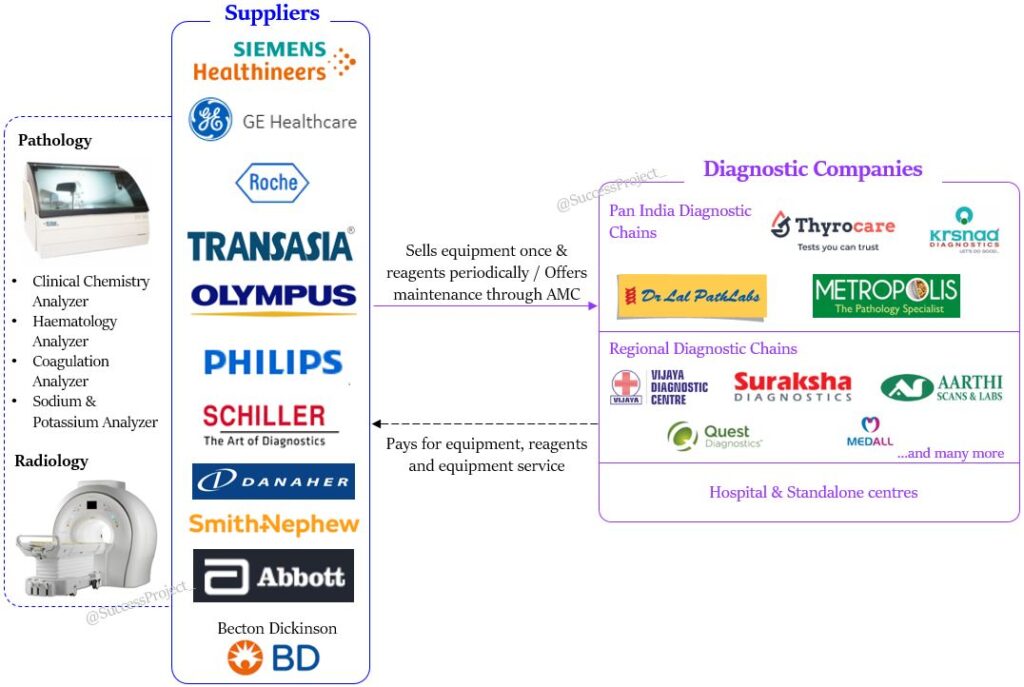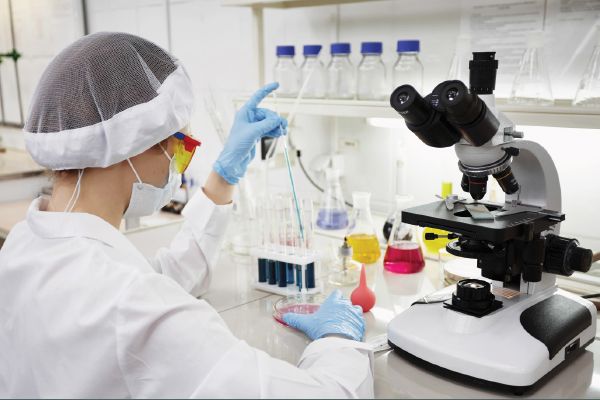In this blog, we will have a complete 360 view of the Diagnostics Industry ecosystem. (Feature image credits: https://ehealth.eletsonline.com/2021/02/future-prospects-of-the-indian-diagnostics-sector-the-resurgence-post-pandemic/)
The following are part of the Diagnostic Industry ecosystem:
- Diagnostic company: The individual companies in the Diagnostic Industry
- Professionals: They work in the Diagnostic companies
- Suppliers: They are vendors supplying equipment and supplies needed for operation of Diagnostic companies
- Customers: They are the end users who pay and receive the services from the Diagnostic companies.
- Logistics Partners: They help in transporting the samples from customers to Diagnostic companies
- Information Technology (IT): Helps to integrate the operations in Diagnostic companies
- Regulations: These are government bodies, agencies and institutions that regulate the industry.
Note: All the above are applicable to large Diagnostic chains (Both Pan India and Regional). However, hospital based and standalone centres may not have all the above. A standalone centre may not have IT operations or logistics partners. A hospital-based centre deals with patients coming to their hospitals. Hence, a logistics partner would not be needed.

Brief Background of this Blog Series
Diagnostics Industry was of interest to me since 2017. However, I could spend dedicated time only during 2021 to study this industry. The contents that you see in the coming blogs were mined from Annual Reports, Concalls, RHP, Management interviews and a few Twitter spaces by Mr Aditya Khemka and Dr Velumani.
Hi, This is Venkatesh. I write on Personal Finance, Stock Investing, Productivity and Time Management. You will be interested to read more about me and the purpose of my website.
If you are interested in these topics do subscribe to my blogs. You would maximum receive 4 to 5 emails a month.
You might also be interested to read these related articles:
Diagnostics Company
This can be considered as the heart of the ecosystem. All the Pathology and Radiology labs in the country belong to the diagnostic company. These companies can be classified as
- Unorganized Sector
- Standalone labs
- Hospital based labs
- Organized Sector
- Pan India Diagnostics chains
- Regional Diagnostics chains
In our earlier blog, we discussed segmentation in a bit more detail. Do read that blog for a detailed understanding of the above classification.

Professionals
They are the professionals working in the diagnostic industry.
Pathologist
A pathologist performs lab test, examines bodies or body tissues. Following are specialized fields:
- Blood banking and transfusion medicine
- Chemical pathology
- Clinical informatics
- Cytopathology
- Dermatopathology
- Forensic pathology
- Hematopathology
- Medical microbiology pathology
- Molecular genetic pathology
- Neuropathology
- Pediatric pathology
Skill shortage: It is estimated that there are 6000 Pathologists to support lakhs of Pathology labs in the country. While Pathology services are responsible for ~70% of clinical decisions. (Data source: Dr Lalpath Lab, Investor meet transcript, November 2021.)
Radiologist
Radiologists are medical doctors that specialize in diagnosing and treating injuries and diseases using medical imaging (radiology) procedures (exams/tests) such as X-rays, computed tomography (CT), magnetic resonance imaging (MRI), nuclear medicine, positron emission tomography (PET) and ultrasound. Following are specialized fields:
- Diagnostic Radiologists
- Interventional Radiologists
- Radiation Oncologists
Phlebotomist
- A professional who draws blood from patients for lab tests, transfusions, or donation.
- Phlebotomists are trained to collect blood via venepuncture (when a needle is used to draw blood out of a vein), finger pricks, or in the case of infants, heel pricks.
- They do not treat patients but work with them closely.
There are many other professionals like Medical Technologist, Microbiologist, Biochemist, Analytical Chemist etc. If you wish to know more details, the below link could be a good starting point.
- https://www.verywellhealth.com/medical-technologist-career-profile-1736165
- https://www.purdue.edu/science/careers/what_can_i_do_with_a_major/Career%20Pages/analytical_chemist.html
- https://study.com/articles/Analytical_Chemist_Job_Description_Duties_and_Requirements.html
While all (or most) of these professionals work in large Diagnostic chains, a Pathologist and/or a Radiologist would be sufficient for small labs and standalone centers.
Suppliers
Who are they?
- The suppliers are manufacturers of “Equipment and instruments”. They are part of the bigger “Medical Equipment and Supplier” segment that we saw in the first blog of the series.
- This sub segment is typically dominated by MNCs like GE Health care, Philips Healthcare, Schiller Healthcare, Fuji Film, Siemens, Danaher corporation, Smith & Nephew and Roche diagnostics are a few to name.
What to they Supply?
They supply the Diagnostics company with equipment’s, accessories and services needed for their daily operations.
Pathology
A Pathology lab needs equipment (Automated analysers) and a chemical component called reagents:
- Automated Analysers: Clinical Chemistry Analyzer, Hematology Analyzer, Coagulation Analyzer, Sodium & Potassium Analyzer etc are a few to name
- Reagents:
- Reagents are substances/chemicals used to produce a chemical reaction so as to detect, measure, or produce other substances.
- In a blood test, the reagents are used/mixed with the blood sample and the equipment’s does the analysis and gives report for the tests. (A similar approach for other samples & body fluids)
- The reagents are consumables that the company needs to buy continuously from the suppliers of the equipment.
Radiology
The supplies would be machines like CT-Scanner, X-Ray machines, MRI Scanner and accessories like image film etc.
This apart diagnostic companies also need consumables and disposables.
Of the above the reagents are an important aspect to understand the business model (Pathology in particular) between the diagnostic company and the suppliers. This shall be discussed in detail in the subsequent blogs.
Servicing of Equipment
- These suppliers provide service of the equipment over an AMC or maintenance of the machine after the warranty period is expired.
- Under most of the contracts, the supplier is responsible for normal servicing and maintenance of equipment and bears the cost of spare parts (excluding consumable spares in certain cases), repairs etc. incurred/necessitated during the contract period.
- However, If any repair results from the failure of Diagnostics company to follow the operations/user manual that accompanies the equipment, operator negligence, sabotage and/or damage caused by employees, agents, visitors, contractors, and contractors’ employees, the supplier will carry out such repair and charge the cost of such repair and spare parts to the Diagnostics company.
- Some suppliers have insurance coverage for the equipment (at their own cost).

To close…
In this blog, we discussed the first three components in the Diagnostics Industry ecosystem. In the next blog, we will cover the remaining four.
Hope you found this blog useful. Do share my blogs with your friends, peers and fellow investors.

